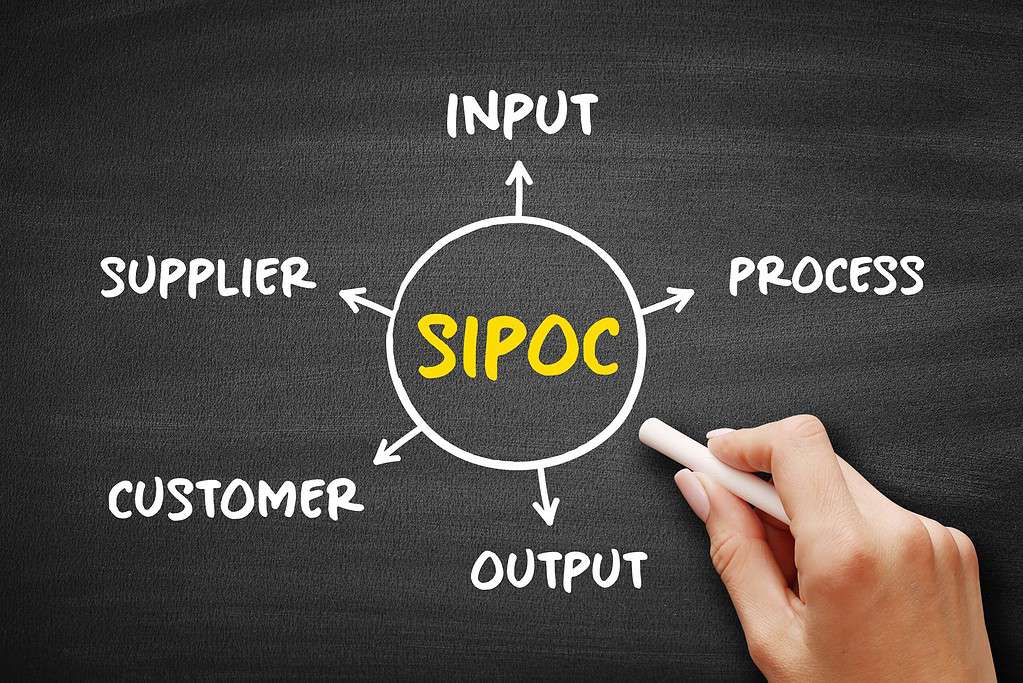
Key Points
- SIPOC diagrams are high-level overviews of the various components of a process.
- There aren’t 1:1 replacements for SIPOC diagrams, but many methodologies and approaches accomplish some of the same goals.
- You want to use the right tool for the job, so make sure you’re reaching for the right thing when the time comes.
Is SIPOC still worth using? Lean and Six Sigma have many tools for improving or designing new processes. You’ll see SIPOC diagrams often touted, but there are other tools where you might find they are better suited for your needs. Today, we’re looking at a few alternatives that might just fit the bill for your process improvement needs.
What Is SIPOC?

A SIPOC diagram is a visual tool used for organizing processes efficiently and effectively. You’re identifying the Supplier, Input, Process, Output, and Customer of each process. These are best used during the Define phase of DMAIC. Typically, you’ll have everyone in a team involved to drill down to the crucial elements of each given process.
While many teams make use of the SIPOC diagram, that is only one part of the puzzle that results in designing better and more effective processes. As it is a high-level diagram, it doesn’t paint a complete picture necessarily.
This has some certain advantages, as we will explore in the next section. However, it doesn’t serve as an effective means of mapping out processes in full. That said, every tool has its place, and the alternatives we’re looking at aren’t comprehensive by any means.
Uses and Strong Suits
So, where is a SIPOC diagram best used? You’ll use one of these early in the production process. Typically, this comes about from the need to display every vital component of a process. As such, you can look at the strong suits like this:
- High-level view
- Shows only vital components
- Keeps everyone on the same page
- Fosters communication
- Promotes transparency
Where the SIPOC falters isn’t so much in its scope, but rather the lack of detail. While you might have identified the viable suppliers in your process, it might not account for raw materials that need ordering. Further, you might need multiple diagrams just to fully encompass a truly complex project.
Alternatives to SIPOC
So, we’ve explored what makes for an effective SIPOC diagram. What’s next? Let’s take a closer look at some of the viable alternatives employed in process improvement projects around the world currently. There are some caveats and drawbacks to each.
However, these tools have different focuses which can give them a distinct edge over the likes of a SIPOC diagram. If you’re looking for something with a little extra meat on its bones once you’re past the conceptual stages, then you’re in the right place.
The 5S Method

The 5S method isn’t what I would call a visualization method by any means. However, it is a framework for establishing safe and effective workplaces for all employees in an organization. It is based around an improvement methodology originating from Toyota Motor Corporation.
At its core are five Japanese terms:
- Seiri (Sort)
- Seiton (Set in Order)
- Seiso (Shine)
- Seiketsu (Standardize)
- Shitsuke (Sustain)
Now, as a visualization method, there is nothing present in 5S to point to getting everyone on the same page. However, when we look at some of the terms represented by each S, and we get a clearer picture. Similar to a SIPOC diagram, you’re fostering open communication while keeping everyone on the same page with proceedings.
Further, you’re putting a framework in place to foster an environment of continuous improvement, which is worth its weight in gold.
Process Mapping
Similar in concept and execution to the SIPOC diagram is process mapping. Like a SIPOC diagram, this is a visualization of all the key workings of your business’s processes. These are involved, at least when compared to the rather Spartan layout of a SIPOC diagram. You can represent as much data as you want.
However, there are some drawbacks to using this visualization tool. It takes time to get proficient at generating these, especially when considering readability for everyone in an organization. As such, it might be worth considering these as a complementary element to your current SIPOC or COPIS diagrams.
Value Stream Mapping
Value stream mapping, or VSM, is a strategy that emphasizes process improvement through mapping out everything needed to accomplish or produce a product or service. This is a fairly detailed methodology. However, it accomplishes some key goals that are similar in scope to a SIPOC diagram.
Where a VSM excels is getting all stakeholders involved in understanding what it takes to produce a product. Further, it fosters open communication between everyone involved in the production line to flesh out the details of a VSM.
However, this is a tool best used later in the DMAIC phases, when you’re taking a closer look at increasing overall efficiency in your production.
Kanban

Now, I can hear you grousing about this. Don’t worry, I hear you. Kanban Boards are a suitable alternative if you’re further along in the development or implementation of a process, making it a suitable replacement to SIPOC diagrams.
A Kanban board is essentially a work management system. You have a board with your processes broken down into its components. Further, you can delegate work to members of your team for each step of a process.
It doesn’t make for an effective means of process improvement, but it does foster an environment of open communication. Your team is going to pitch in to keep track of each task as they progress.
PDCA Cycle
Plan, Do, Check, Act, or the PDCA cycle is a process improvement methodology meant to guarantee quality throughout the development of a process. It doesn’t have a visual component, but it does focus on what matters most in a given process. There are only four steps in this process, meaning it can be implemented rather swiftly.
The first two phases are rather simple in scope and perhaps foster a need for visualization tools. However, the Check and Act phases are the real meat and potatoes of this methodology. This is where the work gets done, with some changes hopefully sticking to increase overall production quality.
TQM
Total Quality Management isn’t necessarily a visualization method, though there are means to visualize with the tools contained within. Instead, TQM is something transformative for an organization. If you’re looking to implement a constant cycle of process improvement, then this might be the ticket for you, however.
TQM is similar in concept to Kaizen but with some distinct differences. Unlike Kaizen, which is a top-down approach to process improvement, TQM focuses on meeting customer needs first and foremost. However, it isn’t something for the faint of heart. If you’re looking to implement TQM, it needs to be something your entire organization is implementing.
That said, TQM does have its distinct benefits. You foster a positive environment and corporate culture in your organization while meeting the growing needs of your customers. As such, it certainly can pay off to implement TQM in your organization today.
Kaizen
Looking to implement continuous improvements into your processes? Then you might do well to implement Kaizen. This is a cultural shift of sorts for any organization, similar in scope to TQM rather than resembling the simplistic graphic of a SIPOC diagram. However, the end goal is ultimately the same for any reader considering these tools.
Kaizen focuses on the strengths of your teams split across an entire organization to make lasting change through incremental improvement. Adopters of Kaizen can also implement sprints, which are a fast method of enacting changes that stick to the process improvement cycle.
What it lacks in visual representation, it more than makes up for in terms of fostering a culture that communicates clearly and effectively. Your teams will need to communicate to make the most of Kaizen, especially as those in leadership positions are setting goals and milestones.
Business Process Management

Our next alternative is also lacking a visual component. However, it is still worth looking at. Business process management is a comprehensive approach to improving processes, and fully transforming organizations to meet their true potential. That said, it is heavily reliant on in-house software development.
On one hand, automating workflows does have some distinct advantages as it makes for stable and efficient processes. On the other hand, you’re forcing a giant upheaval in your organization to get some net gains across the board. That said, some businesses would benefit from the adoption of BPM.
However, it makes for a poor alternative if you’re already entrenched in Lean Six Sigma.
DMADV
What if you had the means to design your products with quality in mind from the get-go? DMADV is a process improvement methodology based on designing your products or services with Lean Six Sigma in mind. To this end, you are designing products that go above and beyond what a customer might expect.
However, it does fall short in a few areas, at least when looking at something like a SIPOC diagram. SIPOC diagrams are readily used for process improvement, which DMADV has no provisions for. Essentially, you’ll be using DMADV for the conceptual design work and implementation of your products.
That said, when it comes time to improve your processes, you’ll be back to DMAIC and tools like SIPOC for visualizing your workflow and getting everyone talking.
Are These Complete Replacements for SIPOC?
So, are the listed alternatives a suitable replacement for the humble SIPOC diagram? That’s a bit of a loaded question, but let’s get right down to it. At the end of the day, there isn’t a complete and comprehensive replacement for the SIPOC or COPIS diagrams.
While there are plenty of visualization tools, methodologies, and approaches you can take to get your business on top, they have different use cases. At any rate, we’ve identified some of the key components of what makes the SIPOC diagram such an indispensable tool in the workplace.
When you get right down to it, the SIPOC diagram is a tool meant to get people talking, and communicating ideas effectively and clearly. You want everyone in your team from the rank-and-file employee to the upper echelons of management on the same page. As such, no, these aren’t complete replacements.
Instead, think of them as something complementary you can utilize when the time comes.
Other Useful Tools and Concepts
Looking for some other useful tools of the trade? You might want to take a closer look at the likes of finding your Sigma Level from customer complaints. If you’re working with an incomplete data set, customer complaints can fill in the gaps.
Additionally, learning how AI can be readily utilized in your DMAIC projects might be of interest. The business world is constantly changing, and AI is one of the latest tools to emerge for supercharging businesses.
Conclusion
At the end of the day, few things are as effective as a SIPOC diagram for communicating ideas at a high-level view. As such, you’ll want to temper your expectations accordingly. While the tools and methodologies suggested are useful for any organization, regardless of your business sector, they have their place.
You wouldn’t use a hammer to cut a board, so why restrict yourself in your organization?